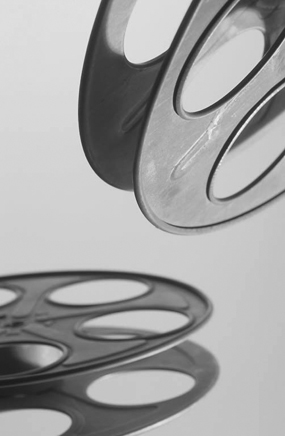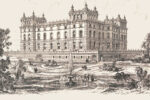Louis Le Prince: A Moving Story

The real-life drama of the inventor of motion pictures…
Keith Spence looks at the life of Louis Le Prince, considered by film historians as the true father of motion pictures, who shot the first moving pictures in Leeds using a single-lens camera.
It has all the classic ingredients of a great film – suspense, intrigue, the mystery disappearance of a famous French inventor, death in the Seine and a lawsuit over millions of dollars. This real-life drama is set in Leeds and, ironically, the principal character is himself the inventor of the moving picture.
 No screenwriter could have come up with a better fictional name than the real one of French inventor Louis Le Prince, who disappeared in 1890 just as it seemed he was going to reveal to the world his invention of moving pictures. Evidence points to the fact that he succeeded in making pictures move at least seven years before the famous Lumiere brothers and Thomas Edison.
No screenwriter could have come up with a better fictional name than the real one of French inventor Louis Le Prince, who disappeared in 1890 just as it seemed he was going to reveal to the world his invention of moving pictures. Evidence points to the fact that he succeeded in making pictures move at least seven years before the famous Lumiere brothers and Thomas Edison.
It all started in West Yorkshire in 1888 when Le Prince, a French photographer working in Leeds, managed to create a few moving images of his back garden and, soon after, did the same on Leeds Bridge.
Le Prince was born in Metz on August 28, 1841. His father, a French Army officer, was a friend of the photographer inventor, Jacques Louis Mande Daguerre. His studio is often visited by Le Prince, who studies chemistry and physics at university before working as a photographer and painter.
“Tinting and firing”
In 1866 he met and became friends with John Whitley, a young British engineer who invited him to join his family engineering firm in Leeds as a designer. In 1869, he married Elizabeth Whitley, John’s sister, who was about to become a significant player in the mysterious story of Le Prince.
According to Elizabeth, the conception of moving photographs and the earliest experiments to find the best material for films, dated back to Park Square, Leeds, where she and her husband established the Leeds Technical School of Art, specialising in the tinting and firing of photographic images on enamel, ceramic and glass.
 In 1882, Le Prince, moved to New York where, in 1886, he produced his 16-lens camera. He returned to Leeds a year later, leaving his wife in New York. At a workshop at 160 Woodhouse Lane he developed a single-lens camera which, in 1888, he then used to make moving picture sequences at the Whitley family home in Roundhay and to shoot trams and horse-drawn traffic on Leeds Bridge.
In 1882, Le Prince, moved to New York where, in 1886, he produced his 16-lens camera. He returned to Leeds a year later, leaving his wife in New York. At a workshop at 160 Woodhouse Lane he developed a single-lens camera which, in 1888, he then used to make moving picture sequences at the Whitley family home in Roundhay and to shoot trams and horse-drawn traffic on Leeds Bridge.
“Inscribed into history”
This is thought to be the first film in the history of cinema. His subject, Leeds Bridge, showed the ebb and flow of humanity. People go about their daily business unaware that their movements are going into film history. The surviving frames for this footage are the property of the National Media Museum in Bradford.
These moving picture sequences using his single-lens camera are created several years before the competing inventors such as Edison (whose first motion picture was made in 1891) and Auguste and Louis Lumiere (who made their first motion pictures in 1892).
In 1890 Le Prince wrote to his wife saying that he was planning to return to New York. On September 16th of that year, before he could patent his work and beset by financial difficulties, he went to France to visit his brother. Mysteriously, he disappeared from a train travelling between Dijon and Paris. This was just before his planned trip to New York. Here he was to publicly display his work for the very first time in America. Despite exhaustive inquiries by his family and the British and French police, neither his body nor his luggage are ever found. Le Prince is never seen again.
“A single gunshot”
 There are many theories surrounding his disappearance. Suicide because he was on the verge of bankruptcy. Assassination, murder for money, even voluntary disappearance at his family’s request because of his alleged homosexuality. His widow backs one of them. That he was assassinated over rival patents from his competitor Thomas Edison. Edison would eventually claim to be the inventor of the moving picture. In 2003, an 1890 photograph of a dead man resembling Le Prince is discovered in Paris police archives.
There are many theories surrounding his disappearance. Suicide because he was on the verge of bankruptcy. Assassination, murder for money, even voluntary disappearance at his family’s request because of his alleged homosexuality. His widow backs one of them. That he was assassinated over rival patents from his competitor Thomas Edison. Edison would eventually claim to be the inventor of the moving picture. In 2003, an 1890 photograph of a dead man resembling Le Prince is discovered in Paris police archives.
In 1898, Le Prince’s eldest son Adolphe, who also collaborated with his father, is called as an eye witness in the family’s litigation against Edison. The family are attempting to gain some recognition for Le Prince’s achievements. Unfortunately their hopes are dashed. Adolphe never gives evidence. He is found dead two years later in New York from a single gunshot wound to the head. Edison wins the case, but later it is overturned.
Last words to Michael Harvey, Curator of Cinematography at the National Media Museum in Bradford. “It was a big mystery about what happened. Police files in Paris show an image of someone who looked like Le Prince who had drowned in the Seine. But the circumstances of his disappearance have never satisfactorily been solved.
“Film fragments”
“In terms of what he achieved he was a pioneer in his field. He thought he had made the invention and was going to unveil it in New York. But he never got to do it. It was apparent there were some strange goings on, but it was pretty unlikely there was a conspiracy theory. Edison was a sharp business man but I don’t think he stooped to murder.”
In 1930, Le Prince’s daughter, Marie, came to Britain for the unveiling of a plaque on the site of her father’s workshop in Leeds. She brought with her two cameras which she presented to the Science Museum. These are currently on show at the National Media Museum in Bradford. Also on show are film fragments of the first images of the Roundhay garden and Leeds Bridge.
Top image courtesy of National Media Museum










FEATURE: Louis Le Prince – How a French-born, Leeds-based inventor changed the world … http://t.co/wZKgQcsH #yorkshire #leeds